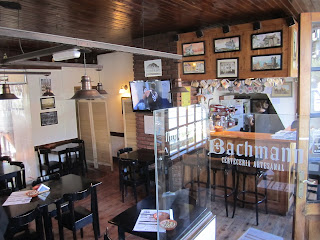 |
| View from the hostel patio |
 |
| Not a stock photo - I actually took this a few kilometres from downtown! |
Aside from gorgeous mountains, lakes, skiing and hiking, chocolate and ice cream, there were in fact several craft breweries in town, and Dr. Libkind was nice enough to suggest a few for Mrs. Hoplog and I to try.
Bachmann
First up was Bachmann, a small operation in a cute house.
Tasters were available, and revealed that their schwarzbier was well worth another taste. All beers were low in alcohol and bitterness, and nicely brewed.
 |
| My name is Chad, and I approve of this beer |
Antares
Next up was Antares, a bigger brewpub with several locations, who also sells their beer in bottles.
The interior was certainly full-on craft beer bar, and it was busy.
The beer selection was excellent, though the quality was a bit lacking compared to Bachmann. Only one beer was what I'd call bad, but none of them were "great." (A lot of forgettable recipes and low-level flaws.) Still, it was a well organized operation that is clearly seeing a lot of success. Some higher-alcohol beers were present, but no hoppy/bitter beers (except the barleywine).
 |
| Nice range of beers, but I'm trying hard to forget that Octoberfest seasonal at the bottom right, ouch |
Manush
We had to wait until Tuesday for Manush to open, but it was worth wait. Very cozy, some nice beers, great food, and truly outstanding service. A must-visit for a meal in Bariloche.
 |
| Happy Hour - 6 until 7 or 8 in Argentina - means 2 for 1 beers, but per person, no sharing! |
 |
| A pretty nice little milk stout at Manush. The Kolsch and Pale Ale were quite passable too |
A couple of preliminary observations on Argentinian craft beer:
- Cerveza artesenal exists in Argentina, and the movement seems to be progressing nicely.
- My perception is that smaller craft breweries have difficulty controlling fermentation temperatures. Perhaps large-scale refrigeration and/or heating is an expense they can't bear. Anyway, many beers are a bit fruitier and "warmer" than usual, and some struggling yeast flavour is common.
- Craft beer is subtle here - brewers aren't cranking out hop bombs and huge imperial stouts. I would guess this is similar to a decade ago in BC, when beer consumers' palettes were still used to macro lager and were not ready for bigger, full-flavour beers. So don't expect it to taste like Portland, OR here. At least not yet.
- If you have allergies, note that most craft beer bars provide all tables with a free snack of peanuts.
More Bariloche brewpubs still to come.





























